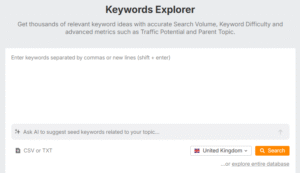Keyword research is one of the foundations of SEO. Put simply, it’s about understanding the words and phrases your customers type into Google, and making sure your content matches what they’re looking for.
When it’s done well, keyword research goes far beyond chasing high-volume search terms. The real value comes from identifying the keywords that not only bring visitors to your site, but also generate leads, sales, and brand awareness. It’s about connecting your audience’s questions with the solutions your business offers.
Why keyword research matters
Think of keyword research as your compass in the ever-changing world of SEO. It guides everything from the content you create to how you optimise your pages and even where you focus your digital PR or link building.
Without it, you’re essentially guessing. You could spend months writing content that never reaches the people it was intended for. Considering that organic search accounts for more than half of all trackable web traffic, it’s too big a channel to ignore.
And with Google owning the lion’s share of the search market, understanding what your audience is actually searching for – and why – is essential if you want to be up there with your main competitors.
Before you begin: Keywords and search intent
What are keywords?
Keywords are the search terms people use to find information online – the words that they type into Google to find a product, service or information. They’re the bridge between your audience’s needs and your content. From a single word (“SEO”) to a full question (“how to do keyword research for SEO”), these terms help Google decide whether your page is relevant.
Why search intent is critical
Behind every keyword is a reason – the intent. In other words, why is your audience searching? What is it they’re looking for? If you don’t match the intent, you won’t rank or convert. Generally speaking, there are four types of intent:
- Informational – the user wants to learn something (“how to do keyword research”)
- Navigational – they’re looking for a specific site (“Google Search Console login”)
- Commercial investigation – they’re comparing options before buying (“Ahrefs vs Semrush”)
- Transactional – they’re ready to buy (“buy SEO software”)
Getting intent right is more important than chasing search volume. A keyword with 100 searches a month but high purchase intent is often more valuable than a keyword with 10,000 vague searches.
Step 1: Define your audience and niche
Keyword research doesn’t start with tools – it starts with knowing your audience.
- Who are you trying to reach?
- What problems are they trying to solve?
- How do they describe those problems?
Building simple personas can help you think like your audience. This makes it much easier to identify keywords that genuinely matter to them.
Step 2: Brainstorm seed keywords
Seed keywords are your starting point. They’re the broad terms that describe your products, services, or topics.
If you run an SEO agency, for example, your seed keywords might be “SEO services”, “content marketing”, or “technical SEO”. These then become the basis for discovering more detailed and specific keywords later on.
Step 3: Check your existing performance
Before looking outward, check what’s already working for you. Google Search Console is a great starting point. The Performance report shows which queries are bringing people to your site, as well as terms where you’re hovering just outside of page one (so-called “striking distance” keywords).

A bit of targeted optimisation here can often deliver quick wins.
Step 4: Expand your list with tools and competitor insights
Free resources
Google itself is a goldmine of information. Look at autocomplete suggestions, the “People Also Ask” boxes, and the related searches at the bottom of the page. Google Keyword Planner (via Ads) is also useful for initial volume estimates.
Paid-for SEO tools
Platforms like Semrush and Ahrefs take things a step further. They provide keyword difficulty scores, SERP features, click-through rate estimates, and huge lists of related terms.

Competitor research
Don’t ignore what’s already working for others. Enter competitor domains into your SEO tool of choice and see which keywords are driving their traffic. Look out for keyword gaps: terms they rank for but you don’t. These often highlight great opportunities.
Step 5: Analyse and prioritise
A long keyword list is a starting point, not the end goal. You need to filter it down to the terms worth focusing on.
Key metrics to consider:
- Search volume – how many people search for it each month
- Keyword difficulty – how tough it will be to rank, based on existing results
- Relevance – does this keyword actually align with your product or service offering?
Then apply the profitability filter: does this keyword have the right intent to drive business results? Phrases like “best”, “services”, “buy” or “pricing” often signal strong commercial intent.
Finally, group your keywords into clusters (e.g. “keyword research tools”, “how to do keyword research”). This helps shape a structured content plan and builds topical authority.
Step 6: Map and optimise
Each keyword cluster should have a dedicated page or piece of content. This process – keyword mapping – prevents your pages competing with each other and ensures you’re covering the topics your audience cares about.
When creating content:
- Use the target keyword naturally in titles, headings, and meta descriptions
- Cover the topic in depth so it answers the query fully
- Add related terms and FAQs to build relevance
Remember: it’s about creating helpful, authoritative content, not keyword stuffing.
Step 7: Monitor, measure, adapt
Keyword research isn’t something you do once and tick off the list. Search behaviour shifts, new competitors emerge, and Google evolves constantly.
Tools like Google Analytics, Search Console, and Google Trends are invaluable for spotting changes. Review your performance regularly, and be prepared to update or expand your content as new opportunities arise.
Keyword research is the backbone of SEO. It ensures you’re not just chasing rankings, but building a strategy that attracts the right audience and drives meaningful results.
By starting with your audience, expanding with the right tools, prioritising based on value and intent, and mapping those keywords into a content plan, you’ll create a strategy that grows over time.
At TAL, we help brands move beyond vanity metrics to build keyword strategies that deliver genuine business outcomes – not just traffic for traffic’s sake.
Want help building a keyword strategy that works for your business? Get in touch with TAL Agency today!


We’d love to chat
The best ideas start with a good old conversation. Let’s have a chat about how we can help you.
Complete the form and one of the directors will be in touch.
Or just pick up the phone and call us, we’re on 03334049888.














